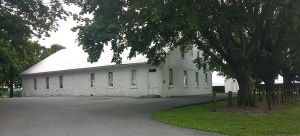Difference between revisions of "Weaverland Old Order Mennonite Church (East Earl, Pennsylvania, USA)"
| [checked revision] | [checked revision] |
GameoAdmin (talk | contribs) (CSV import - 20130820) |
SamSteiner (talk | contribs) (added image) |
||
| Line 1: | Line 1: | ||
| + | __TOC__ | ||
| + | [[File:Weaverland-Mennonite-Meetinghouse-2017.jpg|300px|thumb|''Weaverland Old Order Mennonite Meetinghouse, 2017.<br/>Photo by Collin Miller'']] | ||
Weaverland [[Old Order Mennonites|Old Order Mennonite]] Church was organized by Bishop [[Martin, Jonas H. (1839-1925) |Jonas Martin]] in 1893. The following summer they built a stone meetinghouse 50 x 78 ft, an exact replica of the one built by the united church in 1883 and reserved by the [[Lancaster Mennonite Conference (Mennonite Church USA)|Lancaster Mennonite (Mennonite Church) Conference]]. After the division into the [[Groffdale Old Order Mennonite Conference|Groffdale]] and [[Weaverland Mennonite Conference|Weaverland]] groups in 1926, both groups used this meetinghouse. The Groffdale group, with Aaron Z. Sensenig as bishop, and George G. Horst and Harry H. Martin as ministers, served a membership of 275 in the late 1950s. Their preaching was exclusively in German, with no night services; for transportation they used horse and buggy. It was a part of the Martindale-Weaverland circuit. The Weaverland Conference, meeting on the alternate Sundays, had Joseph O. Weaver as bishop and John B. Weaver as minister, with a membership of 280. They were in the German-English transition during the late 1950s, had no Sunday school nor official church activities, and traveled mostly in automobiles with the bumpers painted black. Both groups were growing in this area. | Weaverland [[Old Order Mennonites|Old Order Mennonite]] Church was organized by Bishop [[Martin, Jonas H. (1839-1925) |Jonas Martin]] in 1893. The following summer they built a stone meetinghouse 50 x 78 ft, an exact replica of the one built by the united church in 1883 and reserved by the [[Lancaster Mennonite Conference (Mennonite Church USA)|Lancaster Mennonite (Mennonite Church) Conference]]. After the division into the [[Groffdale Old Order Mennonite Conference|Groffdale]] and [[Weaverland Mennonite Conference|Weaverland]] groups in 1926, both groups used this meetinghouse. The Groffdale group, with Aaron Z. Sensenig as bishop, and George G. Horst and Harry H. Martin as ministers, served a membership of 275 in the late 1950s. Their preaching was exclusively in German, with no night services; for transportation they used horse and buggy. It was a part of the Martindale-Weaverland circuit. The Weaverland Conference, meeting on the alternate Sundays, had Joseph O. Weaver as bishop and John B. Weaver as minister, with a membership of 280. They were in the German-English transition during the late 1950s, had no Sunday school nor official church activities, and traveled mostly in automobiles with the bumpers painted black. Both groups were growing in this area. | ||
{{GAMEO_footer|hp=Vol. 4, p. 905|date=1959|a1_last=Landis|a1_first=Ira D|a2_last= |a2_first= }} | {{GAMEO_footer|hp=Vol. 4, p. 905|date=1959|a1_last=Landis|a1_first=Ira D|a2_last= |a2_first= }} | ||
Revision as of 20:02, 10 November 2017
Weaverland Old Order Mennonite Church was organized by Bishop Jonas Martin in 1893. The following summer they built a stone meetinghouse 50 x 78 ft, an exact replica of the one built by the united church in 1883 and reserved by the Lancaster Mennonite (Mennonite Church) Conference. After the division into the Groffdale and Weaverland groups in 1926, both groups used this meetinghouse. The Groffdale group, with Aaron Z. Sensenig as bishop, and George G. Horst and Harry H. Martin as ministers, served a membership of 275 in the late 1950s. Their preaching was exclusively in German, with no night services; for transportation they used horse and buggy. It was a part of the Martindale-Weaverland circuit. The Weaverland Conference, meeting on the alternate Sundays, had Joseph O. Weaver as bishop and John B. Weaver as minister, with a membership of 280. They were in the German-English transition during the late 1950s, had no Sunday school nor official church activities, and traveled mostly in automobiles with the bumpers painted black. Both groups were growing in this area.
| Author(s) | Ira D Landis |
|---|---|
| Date Published | 1959 |
Cite This Article
MLA style
Landis, Ira D. "Weaverland Old Order Mennonite Church (East Earl, Pennsylvania, USA)." Global Anabaptist Mennonite Encyclopedia Online. 1959. Web. 18 Apr 2024. https://gameo.org/index.php?title=Weaverland_Old_Order_Mennonite_Church_(East_Earl,_Pennsylvania,_USA)&oldid=155710.
APA style
Landis, Ira D. (1959). Weaverland Old Order Mennonite Church (East Earl, Pennsylvania, USA). Global Anabaptist Mennonite Encyclopedia Online. Retrieved 18 April 2024, from https://gameo.org/index.php?title=Weaverland_Old_Order_Mennonite_Church_(East_Earl,_Pennsylvania,_USA)&oldid=155710.
Adapted by permission of Herald Press, Harrisonburg, Virginia, from Mennonite Encyclopedia, Vol. 4, p. 905. All rights reserved.
©1996-2024 by the Global Anabaptist Mennonite Encyclopedia Online. All rights reserved.

